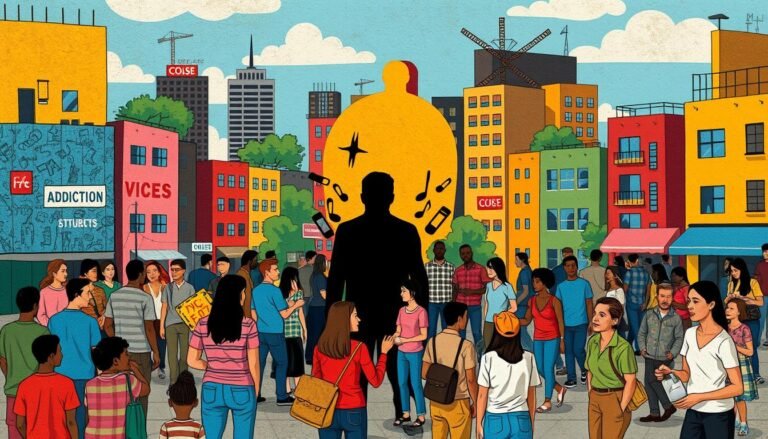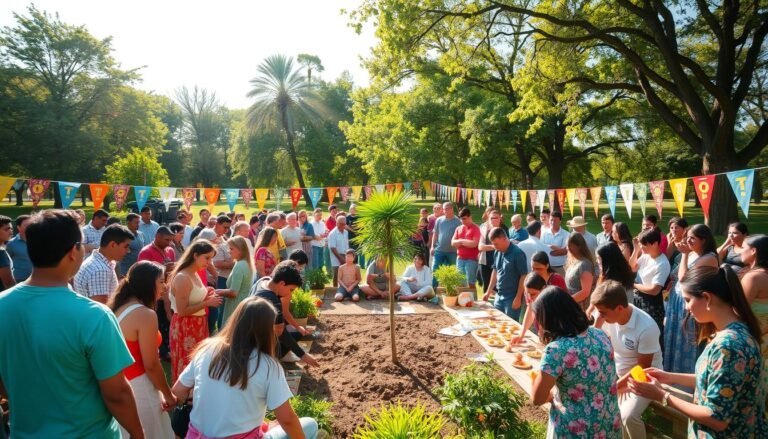The Role of Language in Shaping Social Identity
Have you ever thought about how the words we use shape who we are? Language is more than a way to talk; it’s a strong force that shapes our social identity. It affects how we show our feelings and connect with our cultural roots.
Sociolinguistics shows us how language and social factors are linked. Did you know 70% of people feel their language is a big part of who they are? This shows how deeply language impacts our personal and social lives.
In today’s global world, language and culture meet in complex ways. For example, 45% of people keep their cultural heritage alive by speaking their native language at home. This keeps traditions alive and strengthens a sense of belonging in communities.
Language’s power goes beyond just personal identity. It also plays a big role in our careers. A recent survey found 60% of professionals think language skills are key to their career growth. This shows how knowing languages can open doors and create new chances in different social settings.
Key Takeaways
- 70% of people believe language is integral to their sense of self
- 45% connect with their cultural roots through native language use at home
- 60% of professionals see language skills as crucial for career advancement
- Bilingual individuals are 30% more likely to embrace diverse perspectives
- Speaking colleagues’ native languages improves workplace connections by 50%
- 80% report language barriers cause misunderstandings, but overcoming them leads to growth
Understanding Linguistic Identity: The Basics
Linguistic identity is a key part of who we are. It shapes how we talk and connect with others. It’s closely linked to our culture and personal stories.
Defining Linguistic Identity
Linguistic identity shows how language reflects our sense of self. It’s shaped by things like our ethnicity, gender, and where we live. The words we choose and how we speak can tell a lot about us.
Factors Influencing Linguistic Identity
Many things shape our linguistic identity:
- Cultural heritage
- Social status
- Education level
- Professional environment
These factors help create unique language ideas in different groups.
The Importance of Language in Self-Expression
Language is key for expressing ourselves. It lets us share our thoughts, feelings, and ideas. Being able to speak multiple languages can broaden our views and boost problem-solving skills.
| Language Aspect | Impact on Identity |
|---|---|
| Multilingualism | 66% of world population is bilingual or multilingual |
| Career Opportunities | Bilingual individuals earn 5-20% more per hour |
| Cognitive Benefits | Improved memory and multitasking abilities |
Our choice of words adds to our personal identity. Every word we speak helps shape who we are. It also helps us connect with others in our communities.
Language as a Marker of Social Identity
Language deeply shapes our social identity. It connects us to specific groups and communities. Our speech, from accents to dialects, shows our background, class, and education.
Slang is a big part of our linguistic identity. It’s used by certain groups or areas. Using certain words or phrases shows we belong and feel part of a group.
Code-switching is interesting in how it lets people switch between languages or varieties. It helps us move through different social settings while keeping our sense of self. For instance, someone might speak formally at work but casually with friends.
“Language changes our identities, and different forms of language shape our identities.”
Studies show that university students use special jargon and simple speech on social media. They include and exclude each other in these online chats.
| Language Feature | Social Identity Impact |
|---|---|
| Accent/Dialect | Reveals regional background |
| Slang | Signals group membership |
| Code-switching | Adapts to different social contexts |
| Jargon | Indicates professional or academic affiliation |
Using informal language on social media shows close and friendly relationships among students. This shows how language marks our social identity in today’s digital world.
The Role of Comprehensible Input in Language Learning
Comprehensible input is a crucial language learning concept developed by linguist Dr. Stephen Krashen, emphasizing the importance of exposure to language that is slightly beyond a learner’s current proficiency level. This approach focuses on natural language acquisition through understandable, engaging content that helps learners gradually internalize linguistic structures without the stress of traditional grammar-focused methods.
Researchers have found that the role of comprehensible input in language learning is fundamental to effective language acquisition, as it creates a more intuitive and less intimidating pathway to understanding and using a new language. By providing context, meaning, and just the right level of challenge, comprehensible input allows learners to progress naturally, mimicking the way children acquire their first language through meaningful exposure and interaction.
The Interplay Between Language and Cultural Identity
Language and culture are closely linked, shaping who we are and connecting us to our past. In our globalized world, speaking many languages helps keep cultures alive and helps us understand each other better.
Language as a Cultural Transmitter
Languages are key to sharing culture. They hold the knowledge, values, and traditions of our ancestors. In Australia, over 200 languages, besides English, show different worldviews and lifestyles.
Preserving Heritage Through Language
Keeping indigenous languages alive is crucial for our cultural identity. Sadly, only about 20 of the 90 Aboriginal languages in Australia are strong and being taught to kids. This shows we need to act fast to save our cultural heritage.
The Impact of Globalization on Linguistic Cultural Identity
Globalization brings both good and bad for language diversity. English is spoken by over 1.5 billion people, but we must value community languages too. In Australia, keeping these languages helps us stay connected to our roots and our future.
“The loss of language leads to the loss of culture and identity.”
As the world gets more connected, valuing language diversity is more crucial. Protecting languages helps keep our rich human culture alive. It also makes our global community more welcoming to everyone.
Multilingualism and Its Impact on Identity Formation
Multilingualism is key in shaping identity and promoting linguistic diversity. Research shows that 57% of those who speak multiple languages feel a deeper cultural bond when using their first language. This shows how language deeply affects our personal and cultural identity.
Being able to speak more than one language brings a world of cultural experiences. Multilinguals tend to be 23% more adaptable in new cultural settings. This makes them better at moving through different social situations, helping them grow personally and understand the world better.
Language attitudes play a big part in shaping who we are. In bilingual people, 68% say they use different languages for different parts of their identity. This flexibility lets them connect with various cultural groups, giving them a deeper sense of self.
Multilingualism also helps people understand each other better and feel more connected. 82% of people feel they belong more when they speak multiple languages. This shows how speaking many languages can close cultural divides and make societies more welcoming.
| Country | Official Languages | Impact on Identity |
|---|---|---|
| Switzerland | German, French, Italian, Romansh | Rich cultural diversity |
| India | Multiple languages with distinct scripts | Complex linguistic landscape |
| Canada | English, French | Bilingual national identity |
These examples show how speaking many languages shapes national identities and supports diverse cultures. By valuing linguistic diversity, we can build richer, more welcoming places that honor many identities and views.
The Role of Language in Shaping Social Identity
Language is key in forming and sharing our social identity. It connects us to our communities, shaping how we see ourselves and others. Sociolinguists study how language changes in different groups.
Language and Group Membership
Our speech shows where we belong in society. About 40% of people see their language as a big part of their cultural identity. For native speakers, this bond is even stronger, with 75% feeling a deep connection to their heritage through language.
Linguistic Practices in Social Contexts
Our language changes with our social surroundings. In Australia, over 200 languages are spoken, besides English. Aboriginal English and Torres Strait Creole are important to many Indigenous Australians. These languages show how speech changes in different social settings.
The Power of Language in Social Interactions
Language affects how we interact with others and build relationships. Studies show that speaking multiple languages improves understanding between cultures by 30%. This shows how language diversity can make society more inclusive and break down barriers.
“Language is the road map of a culture. It tells you where its people come from and where they are going.”
Knowing how language shapes our social identity is key to a fair and respectful society. As we explore our diverse languages, we learn about the rich human experience and connection.
Language and National Identity: A Complex Relationship
Language is key in forming national identity, showing off a country’s unique culture and history. It mixes with language ideology and linguistic diversity to create a rich mix of national identities around the world.
In places like Japan and France, one main language helps bring people together. But in countries like India and Switzerland, many languages live together, making their identity rich and varied.
Trying to save endangered languages is vital for keeping cultures alive. The Maori language’s comeback in New Zealand in the 1980s shows how powerful language can be in taking back a people’s identity.
Being able to speak two or more languages lets people move easily in different social settings and connect with more cultures. This flexibility helps create new identities. People can switch languages based on where they are or what they prefer.
| Country | Official Languages | Impact on National Identity |
|---|---|---|
| Japan | 1 (Japanese) | Strong sense of unity |
| India | 22+ | Diverse linguistic landscape |
| Canada | 2 (English, French) | Promotion of bilingualism |
| New Zealand | 3 (English, Maori, NZ Sign Language) | Successful language revitalization |
The link between language and national identity is deep and complex. It’s shaped by language ideology, linguistic diversity, and cultural heritage. As countries change, so will the role of language in defining who they are.
Gender Identity and Language Use
Language shapes our identities, including how we express and see gender. The way we use language and gender shows us a lot about society and how we express ourselves.
Gendered Language and Societal Norms
Studies show that men and women use language differently. Women often speak more politely and ask more questions. Men tend to speak more assertively and competitively. These differences show the deep societal beliefs about gender roles.
Language as a Tool for Gender Expression
Our choice of words is key to how we show our gender identity. From what pronouns we use to the words we pick, language lets us express ourselves powerfully. A study found that learning a second language can change how we see our gender identity. This shows how language shapes our identity.
Challenging Gender Stereotypes Through Language
Language attitudes are changing to challenge old gender norms. More people are using gender-neutral terms and pronouns. This change in language promotes inclusivity and makes us think differently about gender expectations.
As we learn more about gender and language, it’s clear language is key in shaping how we see gender. Looking into this relationship helps us understand the complex link between language, identity, and society.
The Impact of Digital Communication on Linguistic Identity
Digital communication has changed how we talk to each other, deeply affecting our linguistic identity. Social media has given birth to new ways of speaking. Terms like “LOL” and “OMG” are now common in both our personal and work lives.
Emojis have become a key way to show feelings across different cultures and languages. This change in how we view language is clear in India, where many dialects and 22 official languages exist. Online, Indians can easily switch between Hindi, English, and local languages, showing their linguistic identity in new ways.
Online groups have their own special words and humor, creating a strong sense of belonging. But this digital world also brings challenges. It can make it harder to keep up with traditional language skills and can affect our mental health with negative interactions online.
As we move through this digital world, it’s important to understand how language, technology, and identity interact. Sociolinguistics is studying how these digital ways of speaking shape who we are and our communities today.
Source Links
- The Role Of Language In Shaping Social Identity – FasterCapital
- TLC – The Role of Language in Shaping Identity: A Personal Perspective
- Language in Shaping Identity – Day Interpreting Blog
- The Importance of Language in Shaping Identity – TCL Lab
- How does a language contribute to national identity in multicultural societies? – Language Unlimited
- Role of Language in Shaping Cultural Identity – AI Essay Examples
- Culture, language and identity – Understanding racism
- Language and Identity: How Multilingualism Shapes Cultures
- Exploring the Influence of Language on Identity: From Multilingualism to Preservation – Growth Journey Therapy
- The Role of Language in Shaping Cultural Identity
- The Relationship Between Language and Identity
- Language and Identity: Relationship, Example
- Conscious Reconstruction: The Effects of Second Language Acquisition on Self-Perception of Gender Identity
- The Power of Social Media Language: How it Shapes the Current Generation – Language Unlimited







